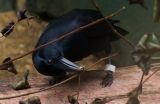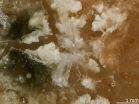(Press-News.org) Mostly untouched for 100 years, 15 Roman-era Egyptian mummy portraits and panel paintings were literally dusted off by scientists and art conservators from Northwestern University and the Phoebe A. Hearst Museum of Anthropology as they set out to investigate the materials the painters used nearly 2,000 years ago.
What the researchers discovered surprised them, because it was hidden from the naked eye: the ancient artists used the pigment Egyptian blue as material for underdrawings and for modulating color -- a finding never before documented. Because blue has to be manufactured, it typically is reserved for very prominent uses, not hidden under other colors.
"This defies our expectations for how Egyptian blue would be used," said Marc Walton, research associate professor of materials science and engineering at Northwestern and an expert on the color blue. "The discovery changes our understanding of how this particular pigment was used by artists in the second century A.D. I suspect we will start to find unusual uses of this colorant in a lot of different works of art, such as wall paintings and sculpture."
The best Roman-era painters tried to emulate Greek painters, who were considered the masters of the art form. Before the Greek period, Egyptian blue was used everywhere throughout the Mediterranean -- in frescoes, on temples, to depict the night sky, as decoration. But when the Greeks came along, their palette relied almost exclusively on yellow, white, black and red.
"When you look at the Tebtunis portraits we studied, that's all you see, those four colors," Walton said. "But when we started doing our analysis, all of a sudden we started to see strange occurrences of this blue pigment, which luminesces. We concluded that although the painters were trying hard not to show they were using this color, they were definitely using blue."
The study was published this month by Applied Physics A, a journal focused on materials science and processing. The research collaboration is part of the Northwestern University-Art Institute of Chicago Center for Scientific Studies in the Arts (NU-ACCESS), for which Walton is a senior scientist.
"Our findings confirm the distinction between the visual and physical natures of artifacts -- expect the unexpected when you begin to analyze an artwork," said Jane L. Williams, a conservator at the Hearst Museum and a co-author, along with Walton, of the study. "We see how these artists manipulated a small palette of pigments, including this unusual use of Egyptian blue, to create a much broader spectrum of hues."
The researchers studied 11 mummy portraits and four panel painting fragments. The 15 paintings were excavated between December 1899 and April 1900 at the site of Tebtunis (now Umm el-Breigat) in the Fayum region of Egypt. They now are housed in the collections of the Hearst Museum at the University of California, Berkeley.
The fragile mummy portraits are extremely lifelike paintings of specific deceased individuals. Each portrait would be incorporated into the mummy wrappings and placed directly over the person's face, Williams explained.
While working on the conservation treatment of these paintings, Williams had many unanswered questions about their materials and techniques, but without a conservation science division at the Hearst Museum, she had limited means to investigate. Working with NU-ACCESS made a comprehensive technical survey of the paintings possible, Williams said.
Walton and his Northwestern team brought expertise in scientific analysis of cultural heritage materials and some of the latest technology for the non-destructive analysis of artworks to the Hearst Museum. The study quickly revealed some surprises.
The researchers uncovered the unexpected uses of Egyptian blue -- the first man-made pigment, inspired by lapis lazuli, the true blue -- using a routine battery of different analytical techniques, such as X-ray fluorescence and X-ray diffraction. Six of the 15 paintings have the unusual use of blue, the researchers found.
The skilled painters employed blue for underdrawings, to modulate clothes, the shading on clothing and in other not necessarily intuitive uses of Egyptian blue, a pigment used for millennia before these paintings were made.
"We are speculating that the blue has a shiny quality to it, that it glistens a little when the light hits the pigment in certain ways," Walton said. "The artists could be exploiting these other properties of the blue color that might not necessarily be intuitive to us at first glance."
Research on these paintings, which is ongoing, will contribute to the international collaborative study project Ancient Panel Paintings: Examination, Analysis and Research (APPEAR), initiated by the J. Paul Getty Museum. APPEAR aims to create an international digital database to compile historic, technical and scientific information on Roman Egyptian portraits.
"Our collaboration with NU-ACCESS makes it possible for the Hearst Museum to contribute to this project at the level of much larger museums, like the Getty or the British Museum, that have conservation science divisions," Williams said.
INFORMATION:
The paper is titled "Investigating the use of Egyptian blue in Roman Egyptian portraits and panels from Tebtunis, Egypt." In addition to Walton and Williams, other authors of the paper are Monica Ganio (first author), Johanna Salvant and Oliver Cossairt, of Northwestern; and Lynn Lee, of the Getty Conservation Institute.
NU-ACCESS is based at Northwestern's McCormick School of Engineering and Applied Science and is supported by a grant from the Andrew W. Mellon Foundation. The center's mission is to provide scientific support for the investigation of art collections, as well as to develop new technology to look at art.
Images are available at https://northwestern.box.com/s/vwoi3ng1bbve64kl7dd1bp7czrmjro2p.
UC San Francisco researchers have for the first time developed a method to precisely control embryonic stem cell differentiation with beams of light, enabling them to be transformed into neurons in response to a precise external cue.
The technique also revealed an internal timer within stem cells that lets them tune out extraneous biological noise but transform rapidly into mature cells when they detect a consistent, appropriate molecular signal, the authors report in a study published online August 26 in Cell Systems.
"We've discovered a basic mechanism the cell uses ...
Companies can promote creativity in employees by encouraging them to network beyond their immediate business networks, according to a new study by management experts at Rice University, Australian National University (ANU), Erasmus University Rotterdam, Monash University in Clayton, Australia, and the University of Los Andes in Bogota, Colombia.
"Social networks can be important sources of information and insight that may spark employee creativity," the authors said. "The cross-fertilization of ideas depends not just on access to information and insights through one's ...
CAMBRIDGE, Mass.--For more than a decade, gene sequencers have been improving more rapidly than the computers required to make sense of their outputs. Searching for DNA sequences in existing genomic databases can already take hours, and the problem is likely to get worse.
Recently, Bonnie Berger's group at MIT's Computer Science and Artificial Intelligence Laboratory (CSAIL) has been investigating techniques to make biological and chemical data easier to analyze by, in some sense, compressing it.
In the latest issue of the journal Cell Systems, Berger and colleagues ...
Among our greatest achievements as humans, some might say, is our cumulative technological culture -- the tool-using acumen that is passed from one generation to the next. As the implements we use on a daily basis are modified and refined over time, they seem to evolve right along with us.
A similar observation might be made regarding the New Caledonian crow, an extremely smart corvid and the only non-human species hypothesized to possess its own cumulative technological culture. How the birds transmit knowledge to each other is the focus of a study by Corina Logan, a ...
Two studies and an editorial published online by JAMA Psychiatry examine associations between cannabis use and the brain.
Cannabis, also known as marijuana, is a popular recreational drug and its legal status has been a source of enduring controversy.
In the first study, David Pagliaccio, Ph.D., formerly of Washington University in St. Louis, and now at the National Institute of Mental Health, Bethesda, Md., and coauthors analyzed data from a group of twin/siblings (n=483 with 262 participants reporting ever using cannabis in their lifetime) to determine whether cannabis ...
Toronto, CANADA - Male teens who experiment with cannabis before age 16, and have a high genetic risk for schizophrenia, show a different brain development trajectory than low risk peers who use cannabis.
The discovery, made from a combined analysis of over 1,500 youth, contributes to a growing body of evidence implicating cannabis use in adolescence and schizophrenia later in life.
The study was led by Baycrest Health Sciences' Rotman Research Institute in Toronto and is reported in JAMA Psychiatry (online) today, ahead of print publication.
Adolescence is a period ...
Putnam Valley, NY. (Aug. 26, 2015) - Liver transplantation is currently the only established treatment for patients with end stage liver failure. However, this treatment is limited by the shortage of donors and the conditional integrity and suitability of the available organs. Transplanting donor hepatocytes (liver cells) into the liver as an alternative to liver transplantation also has drawbacks as the rate of survival of primary hepatocytes is limited and often severe complications can result from the transplantation procedure.
In an effort to find potential therapeutic ...
Washington, DC--New research from a team led by Carnegie's Robert Hazen predicts that Earth has more than 1,500 undiscovered minerals and that the exact mineral diversity of our planet is unique and could not be duplicated anywhere in the cosmos.
Minerals form from novel combinations of elements. These combinations can be facilitated by both geological activity, including volcanoes, plate tectonics, and water-rock interactions, and biological activity, such as chemical reactions with oxygen and organic material.
Nearly a decade ago, Hazen developed the idea that the ...
PHILADELPHIA - In the midst of a growing trend for Medicare patients to receive observation care in the hospital to determine if they should be formally admitted, a new study from researchers at the Perelman School of Medicine at the University of Pennsylvania shows that for more than a quarter of beneficiaries with multiple observation stays, the cumulative out-of-pocket costs of these visits exceeds the deductible they would have owed for an inpatient hospital admission. According to the Medicare Payment Advisory Commission, there were 1.8 million observation patients ...
BATON ROUGE - Ten years after Hurricanes Katrina and Rita devastated the Gulf Coast, LSU researchers have analyzed and documented the recovery effort for the state. Initial reports have been released this week.
Due to the unprecedented destruction of the 2005 storm season, recovery efforts traditionally supported by insurance and FEMA were supplemented by a unique set of programs funded through $13.4 billion of Community Development Block Grant-Disaster Recovery, or CDBG-DR funds.
The researchers from the LSU AgCenter and E. J. Ourso College of Business focused on ...

